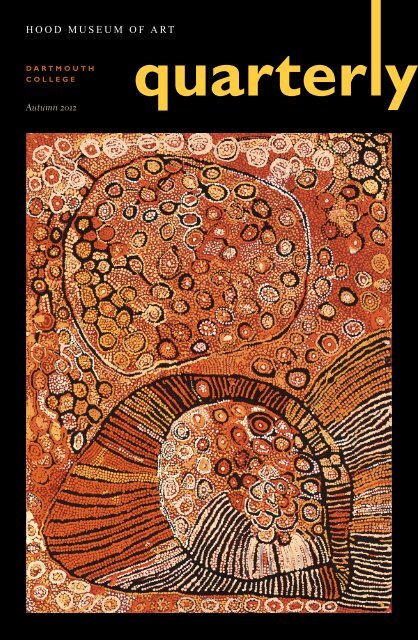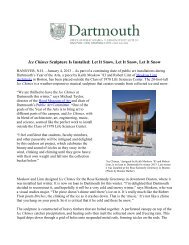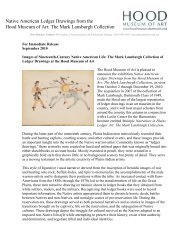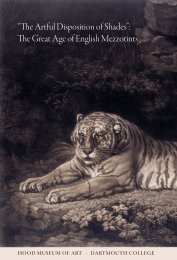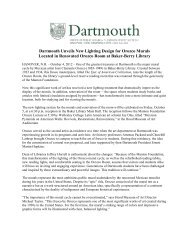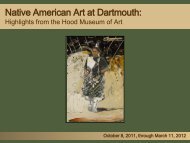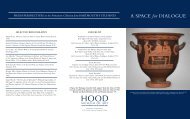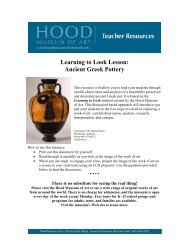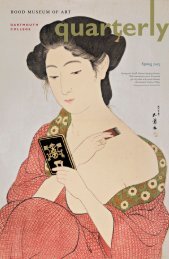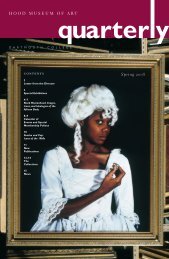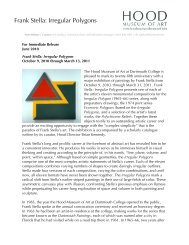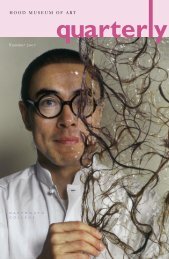Fall 2012 - Hood Museum of Art - Dartmouth College
Fall 2012 - Hood Museum of Art - Dartmouth College
Fall 2012 - Hood Museum of Art - Dartmouth College
Create successful ePaper yourself
Turn your PDF publications into a flip-book with our unique Google optimized e-Paper software.
hood museum <strong>of</strong> art<br />
d a r t m o u t h<br />
college<br />
quarter y<br />
Autumn <strong>2012</strong>
HOOD MUSEUM OF ART STAFF<br />
2<br />
Letter from the Director<br />
Director Michael<br />
Taylor in front <strong>of</strong> Régis<br />
François Gignoux’s<br />
New Hampshire (White<br />
Mountain Landscape),<br />
about 1864, in the<br />
<strong>Hood</strong>’s Sack Gallery.<br />
am thrilled to share this exciting edition <strong>of</strong> the <strong>Hood</strong> Quarterly with you, one that<br />
I is designed to bring all <strong>of</strong> our readers up to date on the imminent renovation and<br />
expansion <strong>of</strong> the <strong>Hood</strong> <strong>Museum</strong> <strong>of</strong> <strong>Art</strong>. The coming years will be a remarkable time<br />
<strong>of</strong> transformation for the museum as we move ahead with a major expansion into the<br />
adjacent historic Wilson Hall building, the renovation <strong>of</strong> the main museum structure,<br />
and an addition to the existing <strong>Hood</strong> building that will include a new <strong>Museum</strong> Learning<br />
Center. Construction will begin at the end <strong>of</strong> 2013, and the <strong>Hood</strong> <strong>Museum</strong> <strong>of</strong> <strong>Art</strong><br />
will reopen two years later in an expanded facility with more art on display and more<br />
programs for you to enjoy.<br />
We begin this issue with an exclusive interview with Tod Williams and Billie Tsien,<br />
the architects for the expansion project, which was conducted earlier this year while<br />
they were on campus for the first <strong>of</strong> many planning sessions with <strong>Hood</strong> staff and senior<br />
<strong>Dartmouth</strong> <strong>College</strong> administrators. As you will see from their comments, Tod and Billie<br />
are fully committed to working with us to position the <strong>Hood</strong> for continued success in<br />
the decades ahead and to ensure our ability to serve our community in fresh and<br />
exciting ways. To achieve this aim, we need to create a museum that truly functions as<br />
a learning center for the twenty-first century, complete with enhanced gallery spaces<br />
that will allow our visitors to experience the works <strong>of</strong> art on display in innovative and<br />
inviting ways, as well as new classrooms equipped with smart technology and exciting<br />
visitor amenities.<br />
The expansion project has been guided by a lengthy strategic planning process at<br />
the <strong>Hood</strong> <strong>Museum</strong> <strong>of</strong> <strong>Art</strong>, during which the entire staff worked to articulate a roadmap<br />
for the museum’s future. A key component <strong>of</strong> our work together was to craft a new and<br />
aspirational mission statement:<br />
The <strong>Hood</strong> <strong>Museum</strong> <strong>of</strong> <strong>Art</strong> is a teaching museum. Our mission is to create an ideal<br />
learning environment that fosters transformative encounters with works <strong>of</strong> art.<br />
With this bold mission statement as our guide, we have outlined strategic goals for<br />
change, growth, and enhancement in ten areas <strong>of</strong> the museum’s operation in the years<br />
ahead. This planning document will be published later this year as a fully illustrated<br />
booklet, but we have outlined the highlights for you in this issue <strong>of</strong> the <strong>Hood</strong> Quarterly.<br />
The inspiration behind the future growth <strong>of</strong> the <strong>Hood</strong> <strong>Museum</strong> <strong>of</strong> <strong>Art</strong>—to make it<br />
increasingly accessible, culturally and intellectually stimulating, and embracing <strong>of</strong> the<br />
best teaching and learning practices in the country—could not be more visible than<br />
with the stunning roster <strong>of</strong> exhibitions and programs that we have on <strong>of</strong>fer this fall. In<br />
celebration <strong>of</strong> <strong>Dartmouth</strong>’s Year <strong>of</strong> the <strong>Art</strong>s (see the story about the campus-wide events<br />
on page 14), we are presenting the groundbreaking exhibition Crossing Cultures: The<br />
Owen and Wagner Collection <strong>of</strong> Contemporary Aboriginal Australian <strong>Art</strong> at the <strong>Hood</strong><br />
<strong>Museum</strong> <strong>of</strong> <strong>Art</strong>. This exhibition, accompanied by a multi-authored and beautifully<br />
illustrated scholarly catalogue, showcases the extraordinary gift by Will Owen and<br />
Harvey Wagner <strong>of</strong> their magnificent collection, which has transformed the <strong>Hood</strong> into<br />
a leading destination for the study and display <strong>of</strong> contemporary Aboriginal Australian<br />
art. Please join us to celebrate the exhibition’s opening on September 21 with a panel<br />
discussion featuring leading Aboriginal Australian scholars entitled “Together Alone:<br />
The Politics <strong>of</strong> Indigeneity and Culture in Australia,” followed by an opening reception<br />
that evening and a special tour the next day with collector and donor Will Owen. I also<br />
urge you to read the calendar <strong>of</strong> events for the many other programs that accompany<br />
this must-see exhibition.<br />
The expansion and renovation <strong>of</strong> the <strong>Hood</strong> <strong>Museum</strong> <strong>of</strong> <strong>Art</strong> means strengthening<br />
our mission as a teaching museum as never before. We will make our diverse collections<br />
and exhibitions more available to all <strong>of</strong> our visitors and deepen our reach into the<br />
<strong>Dartmouth</strong> and local school curricula by making our collections increasingly accessible<br />
through galleries designed to be learning spaces, smart classrooms for the close study <strong>of</strong><br />
objects not on display, and places to make art, study, think, and relax. We look forward<br />
to sharing much more with you in the months ahead; meanwhile, I trust that your next<br />
visit to the museum will be an enjoyable one.<br />
Mic h a e l Ta y l o r<br />
Director<br />
Susan Achenbach, <strong>Art</strong> Handler<br />
Gary Alafat, Security/Buildings Manager<br />
Jonathan Benoit, TMS Project/Digital Asset<br />
Manager<br />
Juliette Bianco, Assistant Director<br />
Lindsey Dewar, Assistant to the Director<br />
Patrick Dunfey, Exhibitions Designer/<br />
Preparations Supervisor<br />
Rebecca Fawcett, Registrarial Assistant<br />
Nicole Gilbert, Exhibitions Coordinator<br />
Stephen Gilchrist, Curator <strong>of</strong> Indigenous<br />
Australian <strong>Art</strong><br />
Cynthia Gilliland, Assistant Registrar<br />
Katherine Hart, Associate Director and Barbara C.<br />
and Harvey P. <strong>Hood</strong> 1918 Curator <strong>of</strong> Academic<br />
Programming<br />
Deborah Haynes, Data Manager<br />
Alfredo Jurado, Security Guard<br />
Amelia Kahl, Coordinator <strong>of</strong> Academic<br />
Programming<br />
Rebecca Karp, Assistant Curator <strong>of</strong> Education<br />
Adrienne Kermond, Tour Coordinator<br />
Vivian Ladd, <strong>Museum</strong> Educator<br />
Barbara MacAdam, Jonathan L. Cohen Curator<br />
<strong>of</strong> American <strong>Art</strong><br />
Nancy McLain, Business Manager<br />
Neely McNulty, Images and <strong>Art</strong>Start Instructor<br />
Nils Nadeau, Communications and Publications<br />
Manager<br />
Allen Newton, Security Guard<br />
Kathleen O’Malley, Associate Registrar<br />
Julie Ann Otis, Development and Membership<br />
Coordinator<br />
Robert Oxman, Security Guard<br />
Alison Palizzolo, Public Relations Assistant<br />
Sarah Powers, Assistant Curator for Special<br />
Projects<br />
Sharon Reed, Programs and Events Coordinator<br />
John Reynolds, Lead Preparator<br />
Mary Ellen Rigby, Gift Shop Manager<br />
Margaret Spicer, Adjunct Curator <strong>of</strong> the Henry B.<br />
Williams Costume Collection<br />
Michael Taylor, Director<br />
Sheldon Tefft, Security Guard<br />
T. Barton Thurber, Curator <strong>of</strong> European <strong>Art</strong><br />
Lesley Wellman, <strong>Hood</strong> Foundation Curator<br />
<strong>of</strong> Education<br />
Kathryn Whittaker, Security Guard<br />
Janet Whyte, Security Guard<br />
Matthew Zayatz, Preparator<br />
<strong>Dartmouth</strong> <strong>College</strong><br />
6 East Wheelock Street<br />
Hanover, New Hampshire 03755<br />
(603) 646-2808<br />
www.hoodmuseum.dartmouth.edu<br />
<strong>Hood</strong> Quarterly #35 (Autumn <strong>2012</strong>)<br />
Edited by Nils Nadeau<br />
Designed by Joanna Bodenweber<br />
Photos by Jeff Nintzel unless indicated otherwise.<br />
Printed by Capital Offset, Inc.<br />
© <strong>2012</strong> Trustees <strong>of</strong> <strong>Dartmouth</strong> <strong>College</strong>
Special<br />
exhibitions<br />
Crossing Cultures<br />
The Owen and Wagner Collection <strong>of</strong><br />
Contemporary Aboriginal Australian <strong>Art</strong><br />
at the <strong>Hood</strong> <strong>Museum</strong> <strong>of</strong> <strong>Art</strong><br />
September 15, <strong>2012</strong>–March 10, 2013<br />
The pr<strong>of</strong>ound knowledge possessed by Indigenous people from<br />
Australia is powerfully communicated through the visualization<br />
<strong>of</strong> ancestral narratives that describe not only how the land was<br />
created but also how to ensure its continued vitality. This exhibition<br />
highlights the extraordinary Owen and Wagner collection at<br />
the <strong>Hood</strong> <strong>Museum</strong> <strong>of</strong> <strong>Art</strong>, <strong>Dartmouth</strong> <strong>College</strong>, through its display<br />
<strong>of</strong> more than one hundred works <strong>of</strong> contemporary Indigenous<br />
art from Australia. It represents the many art-making practices<br />
<strong>of</strong> Aboriginal peoples across the Australian continent, including<br />
acrylic paintings on linen and canvas, earthen ochre paintings<br />
on bark, board, and canvas, sculpture in a variety <strong>of</strong> media, and<br />
photography. While the exhibition features many influential artists<br />
who have contributed to the development <strong>of</strong> an Indigenous<br />
art canon since the 1970s, the focus is squarely on subsequent<br />
generations <strong>of</strong> artists, who are breathing new life into ancient stories<br />
and broadening the possibilities <strong>of</strong> Indigenous art. Resonant<br />
with cultural memory, these objects reference and reinvigorate<br />
customary iconographies, speak to the history and legacy <strong>of</strong> colonization,<br />
and affirm Robert Hughes’s statement that Aboriginal art<br />
is “the last great art movement <strong>of</strong> the twentieth century.”<br />
This exhibition was organized by the <strong>Hood</strong> <strong>Museum</strong> <strong>of</strong> <strong>Art</strong> and generously<br />
supported by Kate and Yaz Krehbiel, Class <strong>of</strong> 1991, Thayer 1992, Hugh J.<br />
Freund, Class <strong>of</strong> 1967, the Leon C. 1927, Charles L. 1955, and Andrew J. 1984<br />
Greenebaum Fund, and the Philip Fowler 1927 Memorial Fund.<br />
(top) Michael Riley, Wiradjuri/Kamilaroi, 1960–2004, Untitled (from the<br />
series cloud), 2004, inkjet print on Ilford Galerie paper, ed. 2/5. Promised<br />
gift <strong>of</strong> Will Owen and Harvey Wagner; EL.2011.60.59. © <strong>2012</strong> <strong>Art</strong>ists<br />
Rights Society (ARS), New York / VISCOPY, Australia<br />
(middle) Pedro Wonaeamirri, Tiwi, born 1974, Untitled, 1999, ochres on<br />
canvas. Gift <strong>of</strong> Will Owen and Harvey Wagner; 2011.43.107. © <strong>2012</strong><br />
<strong>Art</strong>ists Rights Society (ARS), New York / VISCOPY, Australia<br />
(bottom) Craig Koomeeta, Wik-Alkan, born 1977, Min Kéna (Freshwater<br />
Crocodile), 2002, ochres and acrylic on milkwood. Promised gift <strong>of</strong> Will<br />
Owen and Harvey Wagner; EL.2011.60.47. Courtesy <strong>of</strong> the artist and<br />
the Wik and Kugu <strong>Art</strong>s and Craft <strong>Art</strong> Centre.<br />
Stacey Steers: Night Hunter House<br />
August 25–December 16<br />
Gutman Gallery<br />
Night Hunter House, a recent <strong>Hood</strong> acquisition now on view for the first time, is by<br />
Denver-based multimedia artist Stacey Steers. The dollhouse is conceived around and<br />
incorporates segments from Steers’s sixteen-minute handmade film Night Hunter (2011)<br />
on ten small HDTV screens embedded in the house. Visitors who peek into the rooms<br />
through the house’s windows are exposed to a surreal world filled with snakes, giant<br />
moths, pulsating eggs, and strange happenings. Silent film star Lillian Gish (1893–1993)<br />
has been transported from several <strong>of</strong> her best-known films to become the dweller <strong>of</strong><br />
the house and the film’s protagonist through Steers’s expert collage artistry. Steers’s<br />
film Night Hunter (2011), upon which this work is based, will screen continuously in the<br />
<strong>Hood</strong> <strong>Museum</strong> <strong>of</strong> <strong>Art</strong> Auditorium on selected days each week. The schedule is posted<br />
on the <strong>Hood</strong>’s website and in the galleries.<br />
Stacey Steers, Night Hunter House (detail), 2011, mixed media, music and sound by Larry Polansky.<br />
Purchased through the Julia L. Whittier Fund and the Claire and Richard P. Morse 1953 Fund; <strong>2012</strong>.6.<br />
HOOD QUARTERLY 3
Photo by Eli Burak<br />
Photograph © Bruce M. White, <strong>2012</strong><br />
Interview with <strong>Hood</strong> <strong>Museum</strong> <strong>of</strong> <strong>Art</strong><br />
renovation and expansion architects<br />
Tod Williams and Billie Tsien<br />
by Michael Taylor on June 11, <strong>2012</strong><br />
Michael Taylor (MT): Tod and<br />
Billie, what attracted you to this<br />
commission<br />
Tod Williams (TW): You! (laughs)<br />
We heard wonderful things about<br />
you from Philadelphia and that<br />
something new was going to happen<br />
up at <strong>Dartmouth</strong>. We both<br />
went to Ivy League schools and are<br />
incredibly interested in art, so we<br />
had been to the <strong>Hood</strong> and seen its<br />
treasures and its amazing location.<br />
Billie Tsien (BT): We’re also very<br />
interested in the idea <strong>of</strong> a teaching<br />
museum. We go to a lot <strong>of</strong> museums,<br />
but this project addresses a<br />
new paradigm: it is a teaching museum,<br />
not a museum that teaches.<br />
That’s very different from anything<br />
we’ve ever done. Imagining what<br />
that might be is a really interesting<br />
challenge.<br />
MT: Speaking <strong>of</strong> challenges,<br />
what would you say is the biggest<br />
challenge that you face with this<br />
project<br />
TW: Charles Moore, who was<br />
Billie’s thesis advisor, did very<br />
fine work that was just right in the<br />
1980s, but we really need to bring<br />
a fresh face to this. It is crucial<br />
that we create a visible destination<br />
that is woven into the heart <strong>of</strong> the<br />
campus, as opposed to making it an<br />
attractive hidden gem.<br />
BT: I think the really big issue is<br />
how do you unearth the hidden<br />
gem. Another question we are facing<br />
is how can the <strong>Hood</strong> be very<br />
clear about where its front door is<br />
located. With the new Black Family<br />
Visual <strong>Art</strong>s Center, we’re not<br />
only trying to address the Green,<br />
which is the traditional heart <strong>of</strong> the<br />
campus, but we’re now trying to address<br />
a whole arts quadrangle.<br />
TW: And this new arts quadrangle<br />
really may be the future center <strong>of</strong><br />
the town <strong>of</strong> Hanover itself. We see<br />
the <strong>Art</strong>s Plaza as a place around<br />
which Hanover will grow and develop.<br />
<strong>Dartmouth</strong> has always been<br />
invested in the arts, but now we see<br />
that it’s really flourishing.<br />
MT: We are transforming the traditional<br />
idea <strong>of</strong> a museum to include<br />
a <strong>Museum</strong> Learning Center, focusing<br />
on supporting object-based<br />
learning for <strong>Dartmouth</strong> students<br />
in state-<strong>of</strong>-the-art museum classrooms,<br />
which will be something<br />
that any teaching museum around<br />
the world will need in the future.<br />
There isn’t a single department at<br />
<strong>Dartmouth</strong> that wouldn’t benefit<br />
from learning with the collection<br />
at the <strong>Hood</strong>. For example, our<br />
relationship with the Geisel School<br />
<strong>of</strong> Medicine shows us that doctors<br />
can improve their visual diagnostic<br />
skills through the study <strong>of</strong> objects<br />
in the museum.<br />
TW: What’s interesting to us in<br />
your vision is that any student on<br />
the <strong>Dartmouth</strong> campus, anyone<br />
studying any subject, could apply<br />
their study at the <strong>Hood</strong>.<br />
MT: Absolutely. Can you talk a<br />
little bit about how landscaping<br />
will be used to connect us to other<br />
buildings around the Green<br />
TW: The green was the town<br />
center and meeting place in New<br />
England, so the ground plane is<br />
very important to every campus,<br />
every community, every town. At<br />
the same time, you have a unique<br />
condition in that we’re now building<br />
closer together and we have a<br />
more dense and diverse population.<br />
4 HOOD QUARTERLY
The <strong>Hood</strong> expansion project is a<br />
unique opportunity to make visible<br />
connections through the use <strong>of</strong> a<br />
beautiful landscape that runs its<br />
way right through town and that<br />
establishes itself in the vistas and<br />
hills all around us.<br />
MT: What are your thoughts on<br />
Wilson Hall<br />
BT: After walking through Wilson<br />
Hall, I just can’t wait to clean out<br />
everything and take a look at the<br />
bones. There are some incredibly<br />
beautiful and very powerful<br />
spaces in Wilson Hall, and stripping<br />
it down will help us to see, for<br />
example, the height <strong>of</strong> the top floor<br />
and the skylight. People are really<br />
just going to be blown away.<br />
TW: I think we’ve always seen Wilson<br />
as being a solid citizen on the<br />
campus but we might not recognize<br />
it as one <strong>of</strong> the real gems. We want<br />
to release it to its original grandeur<br />
—the turrets themselves are amazing<br />
spaces.<br />
MT: What I loved about your<br />
proposal is that it is really about<br />
bringing back the dignity <strong>of</strong> Wilson<br />
Hall.<br />
TW: We aim to restore its identity<br />
not only as a building with a<br />
remarkable exterior, but one where<br />
the interior is pr<strong>of</strong>oundly connected<br />
to its exterior.<br />
MT: You are highly regarded for<br />
your work at the Phoenix <strong>Museum</strong><br />
<strong>of</strong> <strong>Art</strong>, and you’re just coming <strong>of</strong>f <strong>of</strong><br />
your work with the Barnes Foundation.<br />
Do you feel like the more<br />
museum projects you work on, the<br />
better you are at thinking about<br />
spaces for art, or do you think that<br />
you’ve always had a feel for that<br />
TW: I think we are continuing to<br />
learn. What we’re seeing with the<br />
<strong>Hood</strong> is that there are so many<br />
different ways by which we can<br />
envision the art experience.<br />
BT: I think because art is something<br />
that we love in our own lives,<br />
museum projects excite us. <strong>Art</strong> and<br />
museums are a thread to some <strong>of</strong><br />
the work we’re doing, and each<br />
time we’re learning something<br />
new. I don’t think we ever actually<br />
have the answers because we’re<br />
always looking.<br />
TW: One can be trained to be an<br />
artist, one can be trained to be a<br />
historian, but every child, every<br />
person, intuitively, has an instinctual<br />
sense <strong>of</strong> art. <strong>Art</strong> will continue<br />
to be the part <strong>of</strong> our lives that most<br />
quickly changes, and it does seem<br />
to me that the way art changes<br />
reflects the ways that art versus<br />
society changes. We need to be<br />
ready for change. This is a really<br />
dynamic moment because we’re<br />
beginning to recognize that the arts<br />
are key to our growth as a society.<br />
MT: That’s a wonderful way to<br />
end. Thank you both.<br />
Tod Williams Billie Tsien Architects<br />
is an internationally recognized<br />
firm with a proven track record for<br />
creating breathtakingly beautiful<br />
spaces for displaying works <strong>of</strong> art,<br />
while their building and classroom<br />
designs for the University <strong>of</strong><br />
Chicago, Princeton University, and<br />
the University <strong>of</strong> Pennsylvania are<br />
exemplary in the architectural field.<br />
Their critically acclaimed designs<br />
for the new Barnes Foundation<br />
in Philadelphia, the Phoenix <strong>Art</strong><br />
<strong>Museum</strong>, and the David Rubinstein<br />
Atrium at Lincoln Center all point<br />
to their ability to make the <strong>Hood</strong> a<br />
welcoming, accessible, and visually<br />
engaging place for all visitors.<br />
HOOD QUARTERLY 5<br />
Photograph © Bruce M. White, <strong>2012</strong>
The <strong>Hood</strong> Expands<br />
Creating an Ideal Learning Environment<br />
The <strong>Hood</strong> <strong>Museum</strong> <strong>of</strong> <strong>Art</strong> is a teaching museum. Our mission is to create an ideal<br />
learning environment that fosters transformative encounters with works <strong>of</strong> art.<br />
—<strong>Hood</strong> <strong>Museum</strong> <strong>of</strong> <strong>Art</strong> mission statement, <strong>2012</strong><br />
It is with great excitement that the<br />
<strong>Hood</strong> <strong>Museum</strong> <strong>of</strong> <strong>Art</strong> announces<br />
the renovation and expansion<br />
<strong>of</strong> its award-winning facility. The<br />
museum will close for construction<br />
at the end <strong>of</strong> 2013 and will reopen<br />
with new galleries, a <strong>Museum</strong> Learning<br />
Center, and a welcoming entrance<br />
with new amenities in 2015. The<br />
conceptual vision for the new <strong>Hood</strong><br />
<strong>Museum</strong> <strong>of</strong> <strong>Art</strong> responds directly to<br />
the museum’s mission and role on<br />
<strong>Dartmouth</strong>’s campus and in the community,<br />
and it will be developed and<br />
refined into a design plan over the<br />
next year by Tod Williams Billie Tsien<br />
Architects in conjunction with <strong>Hood</strong><br />
staff, senior <strong>Dartmouth</strong> administrators,<br />
and campus planning leadership.<br />
The vision is grounded in three<br />
beliefs: that an ideal architectural<br />
environment should allow all visitors<br />
to engage in intimate and direct experiences<br />
with the art on view; that<br />
the museum’s strong connection to<br />
the community and campus should<br />
remain apparent in its architectural<br />
design; and that the relationship<br />
among the buildings in the <strong>College</strong>’s<br />
arts district and the surrounding<br />
landscape is critical to a positive campus<br />
and community life.<br />
<strong>Dartmouth</strong> began expansion<br />
planning for the <strong>Hood</strong> in 2010 in<br />
response to the continued growth <strong>of</strong><br />
the museum’s role on campus, a role<br />
that encompasses its collections, exhibitions,<br />
programs, and teaching activity.<br />
<strong>Dartmouth</strong>’s collection—which<br />
dates back to 1772, three years after<br />
the <strong>College</strong> was founded—is among<br />
the oldest and largest <strong>of</strong> its kind in<br />
the United States. Since the <strong>Hood</strong><br />
opened, the collection has increased<br />
from approximately 47,000 works<br />
to more than 70,000 today, which<br />
extend across a broad spectrum<br />
<strong>of</strong> cultures and historical periods.<br />
First conceived without a formal<br />
education department, the <strong>Hood</strong> is<br />
now nationally recognized for the<br />
130 classes and 2,000 <strong>Dartmouth</strong><br />
students it teaches each year in its<br />
Bernstein Study-Storage Center and<br />
in the galleries, and the thousands <strong>of</strong><br />
K–12 school children who visit the<br />
museum in conjunction with their<br />
school curricula. The museum also<br />
organizes more than 150 programs<br />
and events for college, public, and regional<br />
school audiences, and mounts<br />
approximately fifteen exhibitions<br />
each year.<br />
The expanded museum facility will<br />
create new exhibition, educational,<br />
<strong>of</strong>fice, and public spaces. New galleries<br />
will incorporate dedicated display<br />
spaces for African art, Aboriginal<br />
Australian art, modern and contemporary<br />
art, Native American art, and<br />
works on paper, none <strong>of</strong> which are<br />
regularly on view at present due<br />
to space limitations. New visitor<br />
amenities will include a welcoming<br />
atrium with a café, orientation area,<br />
new hands-on studio space, lockers,<br />
restrooms, and places to meet and<br />
study. The museum’s current teaching<br />
spaces, which include the Bernstein<br />
Study-Storage Center and the permanent<br />
collection galleries, no longer<br />
meet the teaching and learning needs<br />
<strong>of</strong> faculty and students or the volume<br />
<strong>of</strong> demand. The three additional<br />
classrooms provided through the<br />
planned <strong>Museum</strong> Learning Center<br />
and the five new galleries will address<br />
the increased interest in direct study<br />
<strong>of</strong> original works <strong>of</strong> art for learners<br />
<strong>of</strong> all ages. Furthermore, the smart<br />
classrooms will enable the contextualization<br />
<strong>of</strong> objects on view through<br />
the use <strong>of</strong> film, the Internet, the<br />
museum’s comprehensive database<br />
<strong>of</strong> its collections, and other forms <strong>of</strong><br />
new media.<br />
6 HOOD QUARTERLY
Encouraged by the museum’s<br />
achievements in the first twenty-five<br />
years <strong>of</strong> its life, we are determined<br />
to be bold and imaginative in our<br />
responses to current and future<br />
opportunities. Below is a brief outline<br />
<strong>of</strong> the main strategic goals in ten<br />
areas <strong>of</strong> the museum’s operation. A<br />
fully illustrated comprehensive planning<br />
document for the growth <strong>of</strong> the<br />
museum will be published by the end<br />
<strong>of</strong> the year.<br />
1. Collections Growth and<br />
Reinstallation: We will broaden<br />
and deepen the collections and<br />
double the gallery space to enable us<br />
to show works currently in storage.<br />
We will also enhance the galleries we<br />
currently have.<br />
2. Collections Storage and Conservation:<br />
We will design new (and<br />
organize existing) storage areas to<br />
support the museum’s teaching mission.<br />
We will conserve more <strong>of</strong> the<br />
collection and reframe paintings and<br />
works on paper for presentation in<br />
the galleries.<br />
3. Collections Access and Digitization:<br />
We will digitize the entire<br />
70,000-object collection by 2019 and<br />
facilitate teaching and learning with<br />
the collections, both in the museum<br />
and its classrooms and in the community<br />
and local schools, with innovative<br />
functionality.<br />
Enjoying events in the <strong>Hood</strong> galleries and studio space. Photos by Jon Gilbert Fox.<br />
4. Exhibitions: We will organize insightful<br />
exhibitions that are the result<br />
<strong>of</strong> new research and scholarship and<br />
organize student-driven exhibitions<br />
that support our teaching mission.<br />
5. Publications: We will publish<br />
books that privilege new scholarship<br />
and interdisciplinary approaches and<br />
are recognized for their superior<br />
design.<br />
6. School and Public Programs:<br />
We will implement innovative new<br />
teaching strategies to strengthen<br />
K–12 object-based learning experience<br />
in the galleries and in the newly<br />
designed studio.<br />
7. Student and Faculty Engagement:<br />
With triple the number <strong>of</strong><br />
object-study classrooms, all equipped<br />
with smart technology, we will be<br />
able to significantly broaden and<br />
deepen our curricular reach. The new<br />
gallery and social spaces will encourage<br />
student non-curricular use <strong>of</strong> the<br />
museum as well.<br />
8. Marketing, Public Relations,<br />
and Membership: We will connect<br />
everyone with the museum’s collection<br />
and teaching practice, strengthen<br />
publicity about the museum worldwide,<br />
and communicate the benefits<br />
<strong>of</strong> mission-focused philanthropy with<br />
all museum donors.<br />
9. Facility, Security, and Visitor<br />
Services: We will utilize the best<br />
technology available for a durable,<br />
efficient, and socially and environmentally<br />
friendly museum and<br />
improve visitor services—including<br />
amenities such as a café, lockers, and<br />
a new entrance that will <strong>of</strong>fer better<br />
front-door accessibility—to support<br />
the museum learning experience.<br />
10. Finance and Human<br />
Resources: We will increase the<br />
staff to accommodate a larger and<br />
more visible museum and build the<br />
endowment to cover this growth<br />
and the museum’s increased operating<br />
costs after the expansion.<br />
This project represents a thrilling<br />
challenge that we wish to share with<br />
everyone: the opportunity to realize<br />
the museum’s full potential as a<br />
model teaching museum. We will<br />
continue to engage with all our audiences<br />
to connect our aspirations<br />
with architectural plans as we enter<br />
the next phase <strong>of</strong> the expansion<br />
process. We look forward to talking<br />
with you and sharing more about<br />
the <strong>Hood</strong>’s expansion in the months<br />
ahead!<br />
Mic h a e l Tay l o r<br />
Director<br />
HOOD QUARTERLY 7
calendar <strong>of</strong> events<br />
All programs are presented in celebration <strong>of</strong> <strong>Dartmouth</strong>’s<br />
Year <strong>of</strong> the <strong>Art</strong>s.<br />
SEPTEMBER<br />
19 September, Wednesday, 6:30–8:00 p.m.<br />
ADULT WORKSHOP<br />
<strong>Art</strong> and Creative Writing<br />
Get inspired at the museum as you try your hand at creative writing.<br />
<strong>Museum</strong> staff will lead participants in a number <strong>of</strong> simple, evocative<br />
writing activities with works <strong>of</strong> art. Writing forms will include poetry<br />
and prose. No previous art or writing experience is necessary.<br />
Participation is limited. Call (603) 646-1469 by September 17 to<br />
register.<br />
21 September, Friday, 3:00–5:30 p.m.<br />
<strong>Hood</strong> <strong>Museum</strong> <strong>of</strong> <strong>Art</strong> Auditorium<br />
PANEL DISCUSSION<br />
“Together Alone: The Politics <strong>of</strong> Indigeneity and Culture<br />
in Australia”<br />
Participants: Brenda L. Cr<strong>of</strong>t, Hetti Perkins, Christian Thompson,<br />
Sonia Smallacombe<br />
Coinciding with the Crossing Cultures exhibition <strong>of</strong> Indigenous art<br />
from Australia, this symposium features a leading Indigenous artist,<br />
curator, activist, and lawyer who will discuss critical issues surrounding<br />
the reception and recognition <strong>of</strong> Indigenous art and the politics<br />
<strong>of</strong> Indigeneity in an increasingly globalized world. Organized by the<br />
<strong>Hood</strong> <strong>Museum</strong> <strong>of</strong> <strong>Art</strong> and cosponsored by the Office <strong>of</strong> the Provost,<br />
the <strong>Museum</strong> Lecture Series Fund, the Leslie Center for the Humanities,<br />
the Dickey Center for International Understanding, and Native<br />
American Studies.<br />
21 September, Friday, 6:00–8:00 p.m.<br />
Kim Gallery<br />
OPENING RECEPTION<br />
Crossing Cultures: The Owen and Wagner Collection <strong>of</strong><br />
Contemporary Aboriginal Australian <strong>Art</strong> at the<br />
<strong>Hood</strong> <strong>Museum</strong> <strong>of</strong> <strong>Art</strong><br />
Join us for the opening celebration <strong>of</strong> the exhibition, featuring a<br />
performance by Oxford-based Indigenous artist Christian Thompson<br />
and exploration in the galleries.<br />
22 September, Saturday, 2:00 p.m.<br />
Second-floor galleries<br />
GALLERY TALK<br />
“American Eyes on Aboriginal <strong>Art</strong>”<br />
Will Owen, private collector<br />
Join collector and donor Will Owen for a fascinating tour <strong>of</strong> the<br />
Crossing Cultures exhibition and learn about his own twenty-year<br />
journey into the art and culture <strong>of</strong> Indigenous Australia.<br />
25 September, Tuesday, 4:30 p.m.<br />
<strong>Hood</strong> <strong>Museum</strong> <strong>of</strong> <strong>Art</strong> Auditorium<br />
ARTIST LECTURE<br />
Christian Thompson<br />
Thompson is a contemporary Indigenous artist from Australia who<br />
works as a photographer, sculptor, and performance artist. Whilst<br />
exploring his Indigenous heritage, Thompson’s work engages with<br />
topics that affect and move both Indigenous and non-Indigenous<br />
audiences. Currently pursuing a doctorate in fine arts at Oxford<br />
University, Thompson will present a lecture on the intersection <strong>of</strong><br />
his current art and academic practice. Presented in coordination<br />
with the Studio <strong>Art</strong> Department lecture series.<br />
OF RELATED INTEREST<br />
27 September, Thursday, 4:15 p.m.<br />
<strong>Hood</strong> <strong>Museum</strong> <strong>of</strong> <strong>Art</strong> Auditorium<br />
THE JAMES AND DAVID ORR MEMORIAL<br />
LECTURE ON CULTURE AND RELIGION<br />
AT DARTMOUTH<br />
“Dreaming the Land, Living the Dream in Australia’s<br />
Western Desert”<br />
Pr<strong>of</strong>essor Robert Tonkinson, Emeritus Pr<strong>of</strong>essor <strong>of</strong> Anthropology,<br />
Senior Honorary Research Fellow, Anthropology and Sociology, The<br />
University <strong>of</strong> Western Australia, Perth<br />
Now in its fortieth year, the Orr Lecture is the most distinguished<br />
lectureship in the Department <strong>of</strong> Religion and one <strong>of</strong> the most<br />
prestigious in the <strong>College</strong>. Organized by the <strong>Dartmouth</strong> Department<br />
<strong>of</strong> Religion. Reception to follow in Kim Gallery.<br />
28 September, Friday, 5:30 p.m.<br />
<strong>Hood</strong> <strong>Museum</strong> <strong>of</strong> <strong>Art</strong> Auditorium<br />
THE DR. ALLEN W. ROOT CONTEMPORARY ART<br />
DISTINGUISHED LECTURESHIP<br />
“What Was Contemporary <strong>Art</strong>: An Introduction”<br />
Richard Meyer, Associate Pr<strong>of</strong>essor, <strong>Art</strong> History and Fine <strong>Art</strong>s<br />
Director, The Contemporary Project University <strong>of</strong> Southern<br />
California<br />
Contemporary art in the early twenty-first century is <strong>of</strong>ten discussed<br />
as though it were a radically new phenomenon unmoored from<br />
history. Yet all works <strong>of</strong> art were once contemporary to the artist<br />
and culture that produced them. Here Richard Meyer reclaims the<br />
contemporary from historical amnesia, exploring episodes in the<br />
study, exhibition, and reception <strong>of</strong> early-twentieth-century art and<br />
visual culture. Reception to follow in Kim Gallery.<br />
OCTOBER<br />
3 October, Wednesday, 6:30–8:30 p.m.<br />
ADULT WORKSHOP<br />
What’s It About New Work by Stacey Steers<br />
Contemporary artist and filmmaker Stacey Steers composes her<br />
films <strong>of</strong> thousands <strong>of</strong> individual handmade works on paper. Recently<br />
she has begun expanding her work to include installations, like the<br />
dollhouse entitled Night Hunter House (currently on view at the<br />
<strong>Hood</strong>), that reflect on and bring focus to her films. Participation is<br />
limited. Call (603) 646-1469 by October 1 to register.<br />
5 October, Friday, 5:30 p.m.<br />
<strong>Hood</strong> <strong>Museum</strong> <strong>of</strong> <strong>Art</strong> Auditorium<br />
THE MANTON FOUNDATION OROZCO LECTURE<br />
AND OROZCO ROOM CELEBRATION<br />
“Mexican Pyramids on American Walls:<br />
Revivals, Restorations, Reinventions”<br />
James Oles, Senior Lecturer, <strong>Art</strong> Department, and Adjunct Curator<br />
<strong>of</strong> Latin American <strong>Art</strong>, Davis <strong>Museum</strong>, Wellesley <strong>College</strong><br />
In 1921, Mexican painter David Alfaro Siqueiros called on his fellow<br />
artists to “absorb the synthetic energy” <strong>of</strong> pre-Columbian civilizations<br />
while “avoiding lamentable archaeological reconstructions.” This<br />
lecture explores the diverse ways that muralists envisioned the architecture<br />
<strong>of</strong> ancient American cities in several murals created in the<br />
United States in the 1930s, including Orozco’s celebrated frescoes at<br />
<strong>Dartmouth</strong>. A reception will follow in the main hall <strong>of</strong> Baker Library.<br />
6 October, Saturday, 2:00 p.m.<br />
TOUR<br />
Crossing Cultures: The Owen and Wagner Collection <strong>of</strong><br />
Contemporary Aboriginal Australian <strong>Art</strong> at the<br />
<strong>Hood</strong> <strong>Museum</strong> <strong>of</strong> <strong>Art</strong><br />
8 HOOD QUARTERLY
27 October, Saturday, 2:00 p.m.<br />
SPECIAL TOUR<br />
Crossing Cultures: The Owen and Wagner Collection <strong>of</strong><br />
Contemporary Aboriginal Australian <strong>Art</strong> at the<br />
<strong>Hood</strong> <strong>Museum</strong> <strong>of</strong> <strong>Art</strong><br />
Stephen Gilchrist, Curator <strong>of</strong> Indigenous Australian <strong>Art</strong><br />
NOVEMBER<br />
3 November, Saturday, 2:00 p.m.<br />
TOUR<br />
Stacey Steers: Night Hunter House<br />
José Clemente Orozco, “Departure <strong>of</strong> Quetzalcoatl,” panel 7 from The Epic <strong>of</strong><br />
American Civilization, 1932–34, fresco, Orozco Room, Baker Library, <strong>Dartmouth</strong><br />
<strong>College</strong>. © Trustees <strong>of</strong> <strong>Dartmouth</strong> <strong>College</strong>. Photo by Jeffrey Nintzel.<br />
9 October, Tuesday, 4:30 p.m.<br />
<strong>Hood</strong> <strong>Museum</strong> <strong>of</strong> <strong>Art</strong> Auditorium<br />
FILM AND ARTIST CONVERSATION<br />
Denver-based artist Stacey Steers and Larry Polansky, the Jacob H.<br />
Strauss 1922 Pr<strong>of</strong>essor in Music at <strong>Dartmouth</strong> <strong>College</strong>, will present<br />
and discuss Steers’s sixteen-minute animated film Night Hunter, with<br />
music by Polansky. The <strong>Hood</strong> has recently acquired Night Hunter<br />
House, a work based on the film and currently on view in the<br />
museum for the first time.<br />
12 October, Friday, 7:00 p.m.<br />
Second-floor galleries<br />
AN EVENING WITH STUDENTS<br />
Crossing Cultures: The Owen and Wagner Collection <strong>of</strong><br />
Contemporary Aboriginal Australian <strong>Art</strong> at the<br />
<strong>Hood</strong> <strong>Museum</strong> <strong>of</strong> <strong>Art</strong><br />
Join four <strong>Dartmouth</strong> students for tours <strong>of</strong> the Crossing Cultures<br />
exhibition: Jason Curley ’13, Nicole Gilbert MALS’14, Elizabeth Neill<br />
’13, and Jeremiah Watchman ’11.<br />
19 October, Friday, 5:30 p.m.<br />
<strong>Hood</strong> <strong>Museum</strong> <strong>of</strong> <strong>Art</strong> Auditorium<br />
THE KENNETH AND HARLE MONTGOMERY<br />
ENDOWMENT LECTURE<br />
“The Djan’kawu Sisters at Yalangbara:<br />
Material Expressions <strong>of</strong> Ancestral Agency”<br />
Howard Morphy, Montgomery Endowment Fellow and Director <strong>of</strong><br />
the Research School <strong>of</strong> the Humanities at the Australian National<br />
University<br />
This lecture will introduce people to Yalangbara, a sacred landscape<br />
on the coast <strong>of</strong> Eastern Arnhem Land in Northern Australia, and to<br />
the ways in which digital technology has enabled its people to bring<br />
images from the past (films, photographs, archival documents, and<br />
photographs <strong>of</strong> material culture collections) back to life in their own<br />
communities. A reception will follow in Kim Gallery.<br />
20 October, Saturday, 2:00 p.m.<br />
Second-floor galleries<br />
GALLERY TALK<br />
“American Eyes on Aboriginal <strong>Art</strong>”<br />
Will Owen, private collector<br />
Join collector and donor Will Owen on a fascinating tour <strong>of</strong> the<br />
Crossing Cultures exhibition and learn about his own twenty-year<br />
journey into the art and culture <strong>of</strong> Indigenous Australia.<br />
24 October, Wednesday, 6:30–8:30 p.m.<br />
ADULT WORKSHOP<br />
Learning to Look at European <strong>Art</strong><br />
Explore some <strong>of</strong> the finest works in the <strong>Hood</strong> <strong>Museum</strong> <strong>of</strong> <strong>Art</strong>’s<br />
collection <strong>of</strong> European art. This informal, discussion-based workshop<br />
will introduce adults to techniques for exploring and appreciating<br />
paintings and sculpture from the Renaissance to the early twentieth<br />
century. No previous art experience necessary. Space is limited. Call<br />
(603) 646-1469 by October 22 to register.<br />
4 November, Sunday, 12:00–5:00 p.m.<br />
FAMILY DAY<br />
Land and Stories in Aboriginal <strong>Art</strong><br />
Travel across the Australian continent to explore contemporary<br />
Indigenous art. In the gallery, learn about rich and varied paintings,<br />
sculptures, and photographs that draw upon ancient stories and<br />
symbols, as well as each artist’s deep connection to the land. In the<br />
studio, use a range <strong>of</strong> materials to create your own work <strong>of</strong> art<br />
inspired by themes and artistic processes explored in the museum.<br />
For children ages 6 to 12 and their adult companions. No preregistration<br />
required. For more information, call (603) 646-1469.<br />
7 and 14 November, Wednesdays, 7:00–8:30 p.m.<br />
ADULT WORKSHOP<br />
Multiple Perspectives: Aboriginal Australian <strong>Art</strong><br />
Over two consecutive Wednesday evenings, join this lively discussionbased<br />
program to explore the exhibition Crossing Cultures. Participants<br />
will engage in looking and writing exercises to appreciate rich<br />
and varied works by Indigenous artists from across the Australian<br />
continent. In the studio, we’ll experiment with different art materials<br />
and artistic methods to further explore ideas discussed in the gallery.<br />
No previous art or writing experience necessary. Participation is<br />
limited. Call (603) 646-1469 by November 5 to register.<br />
13 November, Tuesday, 12:30 p.m.<br />
Second-floor galleries<br />
LUNCHTIME GALLERY TALK<br />
Indigenous Ways <strong>of</strong> Knowing: An Introduction to<br />
Crossing Cultures<br />
Stephen Gilchrist, Curator <strong>of</strong> Indigenous Australian <strong>Art</strong><br />
DECEMBER<br />
1 December, Saturday, 2:00 p.m.<br />
TOUR<br />
Crossing Cultures: The Owen and Wagner Collection <strong>of</strong><br />
Contemporary Aboriginal Australian <strong>Art</strong> at the<br />
<strong>Hood</strong> <strong>Museum</strong> <strong>of</strong> <strong>Art</strong><br />
5 December, Wednesday, 5:30 p.m.<br />
HOLIDAY OPEN HOUSE<br />
Join us a festive evening <strong>of</strong> live, local musical performances, selfguided<br />
art exploration, door prizes, and light refreshments.<br />
All museum exhibitions and events are free and open to the public<br />
unless otherwise noted. For the safety <strong>of</strong> all <strong>of</strong> our visitors, the <strong>Hood</strong><br />
<strong>Museum</strong> <strong>of</strong> <strong>Art</strong> will enforce legal seating capacity limits at every<br />
event in accordance with RSA 153:5 and Life Safety Code 101.<br />
Assistive listening devices are available for all events.<br />
The museum, including the <strong>Art</strong>hur M. Loew Auditorium, is<br />
wheelchair accessible. For accessibility requests, please call<br />
603-646-2808 or e-mail access.hood@dartmouth.edu.<br />
HOOD QUARTERLY 9
C r o s s i n g<br />
C u l t u r e s<br />
The Owen and Wagner<br />
Collection <strong>of</strong> Contemporary<br />
Aboriginal Australian <strong>Art</strong><br />
at the <strong>Hood</strong> <strong>Museum</strong> <strong>of</strong> <strong>Art</strong><br />
September 15, <strong>2012</strong>–March 10, 2013<br />
For Aboriginal people from Australia, the land has always been<br />
the symbolic bedrock <strong>of</strong> cultural knowledge. The shapeshifting<br />
Ancestors who created the land, named it, and passed<br />
down the laws <strong>of</strong> social behavior on epic journeys eventually<br />
metamorphosed into the earth and vested it with their power.<br />
These narratives are reconstituted through ceremonial performances<br />
and cultural art production to ensure the wellbeing <strong>of</strong><br />
the Ancestors, their sites <strong>of</strong> residence, and the people who are<br />
forever connected to them. Within these portraits <strong>of</strong> “country” (a<br />
colloquialism <strong>of</strong> Aboriginal English meaning culturally inherited<br />
tracts <strong>of</strong> land) are incredible systems <strong>of</strong> knowledge that have<br />
contributed to the physical and spiritual survival <strong>of</strong> Aboriginal<br />
people for over 50,000 years. However, following the colonization<br />
<strong>of</strong> Australia in 1788, this knowledge was largely devalorized<br />
by people who chose not to learn its cultural significance or<br />
sophistication. It was not until 1971–72, when senior men began<br />
painting at Papunya using an iconography that had never been<br />
seen by uninitiated men, that Aboriginal material culture began<br />
to be acknowledged as having both artistic and intellectual value.<br />
<strong>Art</strong> has provided the crucial public platform with which Aboriginal<br />
people can make legible certain aspects <strong>of</strong> their cultural<br />
inheritance and demonstrate that we need to see ourselves as<br />
not distinct from the natural world but an inextricable part <strong>of</strong> it.<br />
This exhibition celebrates not only the gifting <strong>of</strong> a significant collection<br />
<strong>of</strong> Aboriginal art by our generous donors Will Owen and<br />
Harvey Wagner but also the gifting <strong>of</strong> ancient knowledge that is<br />
remade anew by contemporary artists.<br />
John Mawurndjul is one <strong>of</strong> Australia’s greatest contemporary<br />
painters and one <strong>of</strong> the few to have had a solo retrospective in a<br />
European art museum. He is a Kuninjku artist from Western Arnhem<br />
Land who lives with his immediate family at Milmilngkan,<br />
an outstation on a tributary <strong>of</strong> the Tomkinson River. He predominantly<br />
uses sheets <strong>of</strong> stringy bark from the eucalyptus tree to<br />
create metaphysical landscapes that resonate with the ancestral<br />
narratives <strong>of</strong> the region. In recent years, the figurative elements<br />
<strong>of</strong> Mawurndjul’s earlier works have receded into the background<br />
and have been replaced with a signature style that invokes sacred<br />
ceremonial body designs called Mardayin. Still embedded within<br />
these abstracted forms and gracile lines are important tenets <strong>of</strong><br />
Kuninjku law that can only be known by those with the appropriate<br />
cultural standing. The great Ancestral Being Ngalyod (the<br />
Rainbow Serpent), who created the sacred lands <strong>of</strong> the Kuninjku<br />
people, resides in the waterhole at Milmilngkan. Ngalyod has<br />
both creative and destructive powers and manifests itself through<br />
the annual monsoonal rains and in the spectacular rainbows<br />
that follow these downpours. In Milmilngkan (2001) (left),<br />
10 HOOD QUARTERLY<br />
John Mawurndjul, Kuninjku, born 1952, Milmilngkan, 2001, ochres<br />
on stringybark. Promised gift <strong>of</strong> Will Owen and Harvey Wagner;<br />
EL.2011.60.13. © <strong>2012</strong> <strong>Art</strong>ists Rights Society (ARS), New York / VISCOPY,<br />
Australia
Mawurndjul showcases his expert handling <strong>of</strong> raark (crosshatching),<br />
which has become his artistic and cultural hallmark. Using<br />
a brush made from his own hair and locally mined earth pigments,<br />
Mawurndjul paints fine linear markings that suggest the<br />
writhing <strong>of</strong> Ngalyod’s powerful serpentine body, light reflecting<br />
<strong>of</strong>f bodies <strong>of</strong> water, and, as a visual metaphor, the ancestral<br />
power that radiates from this site.<br />
Water is also used by Shorty Jangala Robertson to visualize the<br />
power <strong>of</strong> ancestral presence and to demonstrate his knowledge<br />
<strong>of</strong> where it can be reliably found, an essential skill for life in<br />
the Tanami Desert. With a graphic fluidity, his painting depicts<br />
the transformative power <strong>of</strong> water as it courses through a dry<br />
riverbed in the desert (see back cover). The fields <strong>of</strong> colored dots,<br />
applied with a gestural vigor, animate the surface <strong>of</strong> the canvas<br />
and allude to the latent spiritual presence <strong>of</strong> the Ancestors who<br />
shaped and walked through this landscape in the creation period.<br />
The painting recalls the culturally important narrative <strong>of</strong> two<br />
Ancestral men who belong to the Jangala subsection and “sang”<br />
down the rain. They unleashed a great thunderstorm that would<br />
ultimately create the large wells that are fed by underground<br />
springs and provide both physical and spiritual sustenance to the<br />
region’s Warlpiri people.<br />
In a cultural model that values knowledge, seniority is <strong>of</strong>ten<br />
highly prized. But when Samantha Hobson first broke onto the<br />
Aboriginal art scene in her early twenties, it was her commitment<br />
to documenting her own experiences <strong>of</strong> growing up in a dysfunctional<br />
community on the West Cape <strong>of</strong> Cape York Peninsula that<br />
set her apart. And rather than using an iconography that had<br />
been passed down for generations, Hobson instead decided to<br />
forge her own. On monumental canvases, she throws and<br />
sweeps paint into place to document her concern for the Lockhart<br />
River community in which she grew up (see top <strong>of</strong> page). Many<br />
<strong>of</strong> the Lockhart River residents were relocated to its present site<br />
after World War II, and the lack <strong>of</strong> access to the ocean is one <strong>of</strong><br />
the community’s principal discontents. Hobson revels in the<br />
(top) Samantha Hobson, Kuku’yau, born 1981, Wave Break at Night, 2003,<br />
acrylic on canvas. Gift <strong>of</strong> Will Owen and Harvey Wagner; 2011.43.110.<br />
Courtesy <strong>of</strong> the artist and Vivien Anderson Gallery, Melbourne.<br />
(above) Danny Gibson Tjapaltjarri, Pintupi, born 1976, Mukula, 2009, acrylic<br />
on canvas. Promised gift <strong>of</strong> Will Owen and Harvey Wagner; EL.2011.60.35.<br />
© <strong>2012</strong> <strong>Art</strong>ists Rights Society (ARS), New York / VISCOPY, Australia<br />
HOOD QUARTERLY 11
opportunity to spend time on the beach, and her experiential<br />
canvasses transport the viewer to the surreal beauty <strong>of</strong> the waves<br />
breaking <strong>of</strong>f the reef at night.<br />
Christian Thompson is a photographer, sculptor, and performance<br />
artist whose interdisciplinary approach is emblematic <strong>of</strong><br />
his resistance to easy categorizations. In his significant series<br />
Australian Graffiti, Thompson photographs himself wearing<br />
sculptural wreaths and headpieces that are made entirely <strong>of</strong><br />
Australian native flowers (left), playing with the double-hinged<br />
designation “Australian Native.” This term once encompassed<br />
both Indigenous people and the flora and fauna <strong>of</strong> Australia, and<br />
Thompson’s work speaks to the history <strong>of</strong> referring to Indigenous<br />
people under the Commonwealth’s Flora and Fauna Act.<br />
Although deeply critical <strong>of</strong> these dehumanizing classifications,<br />
Thompson nevertheless acknowledges affinity with these flowers,<br />
and the series suggests a deeply symbiotic and sensorial, rather<br />
than fraught or competitive, relationship. As insignia <strong>of</strong> Australia,<br />
these flowers are used on the coat <strong>of</strong> arms, as emblems <strong>of</strong> states<br />
and territories, and to celebrate the centenary <strong>of</strong> Federation.<br />
Thompson’s photographs, however, refuse to be coopted as colonial<br />
trophies and rearticulate the flowers’ central associations<br />
with Indigenous ways <strong>of</strong> caring for the land.<br />
Christian Thompson, Bidjara, born 1978, Black Gum #2, from the series<br />
Australian Graffiti, 2007, C-Type print, ed. 1/10. Promised gift <strong>of</strong> Will Owen<br />
and Harvey Wagner; EL.2011.60.64. Courtesy <strong>of</strong> the artist and Gallery<br />
Gabrielle Pizzi, Melbourne.<br />
This exhibition was organized by the <strong>Hood</strong> <strong>Museum</strong> <strong>of</strong> <strong>Art</strong> and generously<br />
supported by Kate and Yaz Krehbiel, Class <strong>of</strong> 1991, Thayer 1992, Hugh J.<br />
Freund, Class <strong>of</strong> 1967, the Leon C. 1927, Charles L. 1955, and Andrew J. 1984<br />
Greenebaum Fund, and the Philip Fowler 1927 Memorial Fund.<br />
In the forty years since the Papunya boards first appeared in the<br />
public domain, Indigenous artists have transformed the way in<br />
which the landscape can be read and experienced. The land is a<br />
rich archive <strong>of</strong> ancestral presence and cultural memory that continues<br />
to inspire generations <strong>of</strong> Indigenous artists, who are indelibly<br />
connected to the places where these stories first emerged.<br />
Ste p h e n Gilchrist<br />
Curator <strong>of</strong> Indigenous Australian <strong>Art</strong><br />
Teaching with a Collection<br />
In the cold months <strong>of</strong> winter term <strong>2012</strong>, twenty <strong>Dartmouth</strong><br />
students met three days a week to be taken on a journey through<br />
the vibrant regions <strong>of</strong> Australia, learning about the works <strong>of</strong> art<br />
and culturally significant objects produced by Indigenous communities<br />
from the desert to the islands and within urban centers<br />
as well. Stephen Gilchrist, Curator <strong>of</strong> Indigenous Australian <strong>Art</strong><br />
at the <strong>Hood</strong>, focused his undergraduate course, “Indigenous<br />
Australian <strong>Art</strong> and the Politics <strong>of</strong> Curation,” on the aesthetic<br />
values <strong>of</strong> the art but also led discussions on Indigenous identity,<br />
the history <strong>of</strong> the land and people, and the challenges <strong>of</strong> curating<br />
Indigenous Australian art collections within both Australian<br />
and American museums. The class further explored these issues<br />
through group discussion, presentations, writing assignments,<br />
and readings.<br />
I was fortunate to be a member <strong>of</strong> this class as a <strong>Dartmouth</strong><br />
M.A.L.S. student. What added an exceptional dimension to the<br />
course were the classes held in the <strong>Hood</strong>’s Bernstein Study-<br />
Storage Center, where we took in the visual brilliance <strong>of</strong> the<br />
works <strong>of</strong> art firsthand in an intimate setting. As the class sat<br />
encircled by natural ochres skillfully laid upon dried bark, largescale<br />
portrait photography <strong>of</strong> rich tonal qualities, and vibrant<br />
patterns <strong>of</strong> polymer paint dancing across canvases, we considered<br />
not only the artistic techniques <strong>of</strong> each work but also their<br />
sociopolitical attributes and the artists’ intent. The physical presence<br />
<strong>of</strong> these works, otherwise only seen in our textbooks or as<br />
digital reproductions, was now very much alive in front <strong>of</strong> us. We<br />
explored curatorial decisions about how they might be displayed<br />
in a gallery setting and how this would affect and determine<br />
cultural representation.<br />
This fall, Pr<strong>of</strong>essor Howard Morphy, Director <strong>of</strong> the Research<br />
School <strong>of</strong> Humanities and the <strong>Art</strong>s, <strong>College</strong> <strong>of</strong> <strong>Art</strong>s and Social<br />
Sciences at the Australian National University, Canberra, will<br />
teach a course for <strong>Dartmouth</strong> undergraduates through the<br />
Department <strong>of</strong> Anthropology. Morphy’s seminar “Form, Context,<br />
and Meaning in Aboriginal Australian <strong>Art</strong>” will take a comparative<br />
approach, covering the significance <strong>of</strong> art within Aboriginal<br />
society and analyzing the historical processes that led to its<br />
recognition as contemporary fine art. This class will have the<br />
special opportunity to utilize over one hundred works from the<br />
<strong>Hood</strong>’s Owen and Wagner collection <strong>of</strong> contemporary Australian<br />
Aboriginal art, on view throughout the fall in all <strong>of</strong> the secondfloor<br />
galleries.<br />
Nic o l e Gi l b e r t<br />
Exhibitions Coordinator<br />
12 HOOD QUARTERLY<br />
Students in Stephen Gilchrist’s class study the Owen and Wagner contemporary<br />
Aboriginal art collection in Bernstein Study-Storage Center, winter <strong>2012</strong>.<br />
Photo by Amelia Kahl.
New Acquisition<br />
St a c e y St e e r s<br />
Nig h t<br />
Hun t e r<br />
Hou s e<br />
August 25–December 16<br />
Denver-based multimedia artist<br />
Stacey Steers conceived her Night<br />
Hunter House around her sixteenminute<br />
handmade film, shot in<br />
35mm color, titled Night Hunter<br />
(2011). The film, incorporated into<br />
the house itself, is composed <strong>of</strong> more<br />
than four thousand collages, an<br />
intensely laborious process that<br />
Steers completed over a four-year<br />
period. The music and sound from<br />
the film, which are also part <strong>of</strong> this<br />
work, are by Larry Polansky, Jacob<br />
H. Strauss 1922 Pr<strong>of</strong>essor in Music at<br />
<strong>Dartmouth</strong> <strong>College</strong>. The film seamlessly<br />
incorporates images <strong>of</strong> silent<br />
film star Lillian Gish (1893–1993)<br />
taken from her films Broken Blossoms,<br />
Way Down East (part <strong>of</strong> which<br />
was filmed in White River Junction,<br />
Vermont), and True Heart Susie,<br />
among others. Night Hunter House<br />
literally places Gish in a nightmare<br />
world filled with snakes, giant moths,<br />
pulsating eggs, and a deep, dark forest,<br />
into which she disappears at the<br />
end <strong>of</strong> the film in a moment reminiscent<br />
<strong>of</strong> classic fairy tales, although<br />
her fate is far from clear.<br />
This three-foot-tall black Victorian<br />
dollhouse was built by Steers<br />
with design and construction help<br />
from architect Mark S<strong>of</strong>ield and<br />
Michael Schliske <strong>of</strong> Steamboat<br />
Woodworks. It is outfitted with ten<br />
rooms that recreate those within<br />
which the scenes from the film take<br />
place, and each room contains a<br />
small HDTV screen that loops the<br />
segment <strong>of</strong> the film connected to<br />
the space. The intricately furnished<br />
interiors are filled with furniture,<br />
light fixtures, antique lace, curtains,<br />
implements, bird eggs, and moth<br />
specimens. The base <strong>of</strong> the house<br />
depicts the forest at the end <strong>of</strong> the<br />
film. Viewers therefore are invited<br />
to experience the dream along with<br />
Gish by peering into each <strong>of</strong> the<br />
windows <strong>of</strong> the house and observing<br />
its contents as well as the film.<br />
Night Hunter House evokes the<br />
surrealist landscapes and collages<br />
<strong>of</strong> Max Ernst and the otherworldly<br />
boxes <strong>of</strong> his contemporary Joseph<br />
Cornell. Steers also cites contemporary<br />
artist William Kentridge as a<br />
stylistic influence. In addition, the<br />
structure or image <strong>of</strong> the house is one<br />
that has been used by feminist artists<br />
to explore femininity and the roles <strong>of</strong><br />
Stacey Steers, Night Hunter House, 2011,<br />
mixed media, music and sound by Larry Polansky.<br />
Purchased through the Julia L. Whittier<br />
Fund and the Claire and Richard P. Morse<br />
1953 Fund; <strong>2012</strong>.6.<br />
women in society. Steers reverses the<br />
idea <strong>of</strong> the house as a “safe haven”<br />
in this work. The “dangerous” forest<br />
that threatened Little Red Riding<br />
<strong>Hood</strong>—among other female<br />
archetypes—becomes the place <strong>of</strong><br />
escape, although its pulsating darkness<br />
is no less threatening than the<br />
activity within the house.<br />
A central theme <strong>of</strong> Night Hunter<br />
House is that <strong>of</strong> transition, both biological<br />
and metaphorical. Not only<br />
does Steers’s filmmaking process <strong>of</strong><br />
handmade collage embrace transition<br />
by its very nature, but the visitor’s<br />
experience <strong>of</strong> the house, from<br />
the tidy foyer and living room below<br />
to the violently disrupted attic above,<br />
parallels the protagonist’s transition<br />
within it. As she slowly realizes she<br />
is changing from human to bird, she<br />
encounters another uniquely female<br />
state <strong>of</strong> impermanence: gestation.<br />
Indeed, Steers draws our attention to<br />
the relationship between the house<br />
and the female body—one could<br />
argue that the house is a body—and<br />
peering into its windows thereby<br />
implies a certain intimacy on the<br />
part <strong>of</strong> the viewer.<br />
A new acquisition on view to<br />
the public for the first time, Night<br />
Hunter House exemplifies contemporary<br />
multi-media and collaborative<br />
art making. Because <strong>of</strong> the multifaceted<br />
themes that Steers explores, it<br />
has the potential to connect to the<br />
curriculum at <strong>Dartmouth</strong> <strong>College</strong><br />
in a variety <strong>of</strong> disciplines, including<br />
art history, studio art, women’s and<br />
gender studies, French and Italian,<br />
philosophy, music, history, theater,<br />
English, and film and media studies.<br />
Jul i e t t e Bi a n c o<br />
Assistant Director<br />
HOOD QUARTERLY 13
The Year <strong>of</strong> the <strong>Art</strong>s at <strong>Dartmouth</strong><br />
The <strong>Hood</strong> <strong>Museum</strong> <strong>of</strong> <strong>Art</strong> is excited<br />
to be part <strong>of</strong> <strong>Dartmouth</strong>’s<br />
Year <strong>of</strong> the <strong>Art</strong>s during the <strong>2012</strong>–13<br />
academic year. This campus-wide<br />
initiative <strong>of</strong> special artistic programs<br />
will highlight the vibrant arts culture<br />
at <strong>Dartmouth</strong> and underscore its<br />
position as one <strong>of</strong> the nation’s leading<br />
academic arts communities, where<br />
the undergraduate experience is<br />
defined by an interdisciplinary approach<br />
to art that engages students in<br />
a variety <strong>of</strong> ways and settings.<br />
The celebration is timed to<br />
coincide with the inauguration <strong>of</strong><br />
<strong>Dartmouth</strong>’s new <strong>Art</strong>s District, comprising<br />
the recently completed Black<br />
Family Visual <strong>Art</strong>s Center, the <strong>Hood</strong><br />
<strong>Museum</strong> <strong>of</strong> <strong>Art</strong>, and the Hopkins<br />
Center for the <strong>Art</strong>s, as well as the arts<br />
plaza that is situated between the<br />
three buildings. The <strong>Hood</strong> and the<br />
Hop are both planning expansion<br />
and renovation projects in the coming<br />
years that will begin to take shape<br />
during the Year <strong>of</strong> the <strong>Art</strong>s, adding<br />
excitement and momentum to this<br />
initiative, as <strong>Dartmouth</strong> reaffirms its<br />
commitment to the arts.<br />
Notable arts programming<br />
during the next academic year will<br />
include two groundbreaking exhibitions<br />
at the <strong>Hood</strong> (Crossing Cultures:<br />
The Owen and Wagner Collection <strong>of</strong><br />
Contemporary Aboriginal Australian<br />
<strong>Art</strong> at the <strong>Hood</strong> <strong>Museum</strong> <strong>of</strong> <strong>Art</strong> and<br />
The Women <strong>of</strong> Shin Hanga: The<br />
Judith and Joseph Barker Collection<br />
<strong>of</strong> Early-Twentieth-Century Japanese<br />
Prints); the 50th anniversary celebration<br />
<strong>of</strong> the Hopkins Center, with<br />
special performances by Yo-Yo Ma,<br />
John Lithgow, and Wynton Marsalis,<br />
among many others; Montgomery<br />
Fellows in residence on campus<br />
including the <strong>Art</strong>istic Director <strong>of</strong><br />
Alvin Ailey American Dance Theater<br />
Robert Battle, anthropologist and<br />
Aboriginal Australian art and culture<br />
scholar Howard Morphy, and Adrian<br />
Kohler and Basil Jones, co-founders<br />
<strong>of</strong> the internationally renowned and<br />
Tony Award–winning Handspring<br />
Puppet Company; a special film<br />
series that will bring films and organizers<br />
from the international film<br />
festival circuit to Hanover; and many<br />
other art-related events. The arts<br />
are integral to the intellectual and<br />
cultural vibrancy <strong>of</strong> any community,<br />
and we believe that the exhibitions,<br />
performances, and programs that will<br />
take place during the Year <strong>of</strong> the <strong>Art</strong>s<br />
will be exciting and inspiring to all <strong>of</strong><br />
our visitors.<br />
<strong>Dartmouth</strong> has long championed<br />
the integration <strong>of</strong> the arts into<br />
an academic setting: campus initiatives<br />
have included the establishment<br />
in 1932 <strong>of</strong> a prestigious artistin-residence<br />
program that continues<br />
to this day, former participants <strong>of</strong><br />
which include such notable artists<br />
as José Clemente Orozco, Robert<br />
Rauschenberg, Frank Stella, Alison<br />
Saar, and most recently Ying Li; the<br />
1962 opening <strong>of</strong> the Hopkins Center<br />
as one <strong>of</strong> the nation’s first campus-based<br />
performing arts centers;<br />
and the 1985 opening <strong>of</strong> the <strong>Hood</strong><br />
<strong>Museum</strong> <strong>of</strong> <strong>Art</strong>, designed to house<br />
one <strong>of</strong> the oldest and largest college<br />
or university-based art collections<br />
in the United States. The diverse<br />
series <strong>of</strong> arts programs and initiatives<br />
taking place during <strong>Dartmouth</strong>’s<br />
<strong>2012</strong>–13 academic year—including an<br />
unprecedented number <strong>of</strong> programs<br />
and partnerships that have been developed<br />
by departments and campus<br />
organizations that are not traditionally<br />
affiliated with the arts—exemplify<br />
this historic commitment to leadership<br />
in the arts, while simultaneously<br />
establishing <strong>Dartmouth</strong> as a model<br />
for the artistic campus <strong>of</strong> the twentyfirst<br />
century.<br />
Ess i Rö n k k ö<br />
Year <strong>of</strong> the <strong>Art</strong>s Coordinator<br />
The <strong>Hood</strong>’s programming throughout<br />
the year will be presented in celebration<br />
<strong>of</strong> the “Year <strong>of</strong> the <strong>Art</strong>s” initiative.<br />
Hashiguchi Goyō, Woman Combing Her Hair, 1920, print. The Judith and Joseph Barker<br />
Collection.<br />
14 HOOD QUARTERLY
museum<br />
news<br />
New Docents Ready to Help<br />
<strong>Museum</strong> Visitors Learn about <strong>Art</strong><br />
The <strong>Hood</strong> is delighted to welcome<br />
nine new docents to our team <strong>of</strong> gallery<br />
teachers. Docents are community<br />
members who serve on a volunteer basis<br />
and provide tours <strong>of</strong> the museum’s collections<br />
and special exhibitions to visiting<br />
groups <strong>of</strong> all ages. They also help staff<br />
other programs, such as Family Days and<br />
museum-wide events. Participation in the<br />
docent program requires a substantial<br />
commitment <strong>of</strong> time and energy, but it is<br />
tremendously rewarding.<br />
While there are no fixed qualifications<br />
for becoming a docent, previous knowledge<br />
<strong>of</strong> and experience with art history,<br />
studio art, teaching, or public speaking<br />
are desirable. Most important, however,<br />
are a love and enthusiasm for art, strong<br />
listening and people skills, flexibility, openness<br />
and willingness to learn and try new<br />
things, and an ability to communicate and<br />
work well with a diverse range <strong>of</strong> people.<br />
The docent application process was<br />
rigorous and selective. The group compressed<br />
a year’s worth <strong>of</strong> training into<br />
five months to learn how to teach in the<br />
galleries, attending sessions two mornings<br />
each week as well as doing homework<br />
assignments. Training included teaching<br />
strategies and techniques modeled by<br />
members <strong>of</strong> the museum’s education staff<br />
and guest presenters as well as information<br />
sessions about the collections, the<br />
Orozco fresco, and special exhibitions<br />
led by curators and <strong>Dartmouth</strong> pr<strong>of</strong>essors.<br />
Trainees had to practice-teach four<br />
different times throughout the course,<br />
including crafting and giving a tour in<br />
collaboration with their fellow training<br />
docents. They also observed seasoned<br />
docents and education staff leading tours<br />
and were evaluated in their own presentations—by<br />
themselves, their peers, and<br />
members <strong>of</strong> the museum education staff.<br />
The nine new docents are now eager<br />
to lead tours in the museum for school<br />
and community groups. They join a team<br />
<strong>of</strong> ten seasoned docents who have been<br />
helping visitors learn about art for many<br />
years: Mary Ann Cadwallader, Margie<br />
Cook, Mary Cooper, Carol Du Bois,<br />
Nan Green, Kate Hewitt, Roland Kuchel,<br />
Judy Oxman, Donna Reilly, and Sybil<br />
Williamson.<br />
New docents, left to right: Jan Sayles, Julie<br />
Goodrich, Claire Lyon, Noelle Vitt, Calli Guion,<br />
Francesca Gabourel, Susan Wright, Margie<br />
Carpenter. (Linda Oidtmann not pictured.)<br />
Meet Brooke and James “Jim”<br />
Adler ’60, Tu ’61: Lathrop Fellows<br />
Members since 1999<br />
Founded in 1990, the Lathrop Fellows has<br />
been invaluable to the museum’s efforts<br />
to develop our permanent collection<br />
and support exhibitions and educational<br />
programs. Now part <strong>of</strong> <strong>Hood</strong> Membership,<br />
the Lathrop Fellows represents a<br />
wonderful opportunity to learn more<br />
about the arts in the company <strong>of</strong> others<br />
who wish to demonstrate their support<br />
for the museum.<br />
What attracted you to become<br />
Lathrop Fellows<br />
We had friends who were traveling to<br />
Santa Fe as Lathrop Fellows in 1999.<br />
The opportunity to travel with museum<br />
staff and benefit from their knowledge<br />
was a big draw. We thought it would<br />
be a terrific way to support our “town<br />
museum.” We now know more about<br />
contemporary art in particular because<br />
<strong>of</strong> our experiences both at the <strong>Hood</strong> and<br />
on these trips.<br />
What is your favorite work <strong>of</strong> art in<br />
the collection<br />
We are in complete agreement on this<br />
one—Beaver Meadow by Paul Sample!<br />
We love his style and the artistic tradition<br />
he came from, and we live nearby.<br />
The painting is so iconic, reflecting on our<br />
rural Vermont life—not quite what it was<br />
then, but there are still elements <strong>of</strong> the<br />
pastoral that persist. There is a sensibility<br />
about it that speaks to a simpler time and<br />
a simpler life, and the painting’s colors<br />
reinforce the s<strong>of</strong>tness <strong>of</strong> it. We must also<br />
mention the Orozco mural—you have to<br />
put the power <strong>of</strong> that work above and<br />
beyond everything at <strong>Dartmouth</strong>.<br />
What was your favorite exhibition<br />
at the <strong>Hood</strong><br />
We agreed on this too, but we have to<br />
name three. Bringing the artist to speak<br />
is something the <strong>Hood</strong> does so well,<br />
which really engaged us with Sean Scully:<br />
The <strong>Art</strong> <strong>of</strong> the Stripe (2008) and Frank<br />
Stella: Irregular Polygons (2010). Last but<br />
not least was Native American <strong>Art</strong> at<br />
<strong>Dartmouth</strong> (2011–12), first because it<br />
honors <strong>Dartmouth</strong>’s commitment to its<br />
founding charter. It wasn’t just seeing the<br />
wonderful historic collection, but also<br />
the way the museum integrated it with<br />
great contemporary Native art. We had<br />
met Mateo Romero in Santa Fe on that<br />
first Lathrop Fellows trip we mentioned,<br />
and then to see him as a mature artist<br />
presenting his Pow-Wow Suite thirteen<br />
years later was thrilling.<br />
Why would you recommend others<br />
to become members <strong>of</strong> the <strong>Hood</strong><br />
<strong>Museum</strong> <strong>of</strong> <strong>Art</strong><br />
The connections and outreach that the<br />
<strong>Hood</strong> makes with the arts community<br />
is tremendous. The great gift <strong>of</strong> having a<br />
first-class museum in a rural area is that<br />
you can support the art education <strong>of</strong><br />
children throughout the region.<br />
Please join or renew TODAY at any<br />
level <strong>of</strong> membership!<br />
To sign up, email hoodmembership@<br />
dartmouth.edu or call Julie Ann Otis at<br />
(603) 646-0414. For more information,<br />
visit hoodmuseum.dartmouth.edu and<br />
click on “join us.” Interested in learning<br />
more about the Lathrop Fellows Ask<br />
Julie Ann!<br />
HOOD QUARTERLY 15
General Information<br />
<strong>Museum</strong> and Shop Hours<br />
Tuesday–Saturday: 10 a.m.–5 p.m.<br />
Sunday: 12 noon–5 p.m.<br />
Wednesday evening to 9 p.m.<br />
Guided Group Tours<br />
Available by appointment: call (603) 646-1469<br />
for information.<br />
Assistive listening devices are available for all<br />
events. The museum, including the <strong>Hood</strong><br />
<strong>Museum</strong> <strong>of</strong> <strong>Art</strong> Auditorium, is wheelchair<br />
accessible.<br />
Admission and Parking<br />
There is no admission charge for entrance to<br />
the museum. Metered public parking is available<br />
in front <strong>of</strong> the museum on Wheelock<br />
Street and behind the museum on Lebanon<br />
Street. All-day public parking is available at<br />
the Parking Garage on Lebanon Street.<br />
ACCREDITED<br />
by<br />
the AMERICAN ASSOCIATION<br />
OF MUSEUMS<br />
•<br />
For more information, please call<br />
(603) 646-2808 or visit our Web site at<br />
www.hoodmuseum.dartmouth.edu.<br />
<strong>Hood</strong> <strong>Museum</strong> <strong>of</strong> <strong>Art</strong><br />
<strong>Dartmouth</strong> <strong>College</strong><br />
6 East Wheelock St.<br />
Hanover, NH 03755<br />
Non-Pr<strong>of</strong>it Org.<br />
US Postage<br />
PAID<br />
<strong>Dartmouth</strong> <strong>College</strong><br />
ACCREDITED<br />
by<br />
the AMERICAN ASSOCIATION<br />
OF MUSEUMS<br />
•<br />
Advertising for the <strong>Hood</strong> <strong>Museum</strong> <strong>of</strong> <strong>Art</strong>’s exhibitions and<br />
programs has been generously underwritten by the Point and<br />
the Junction Frame Shop.<br />
The <strong>Hood</strong> <strong>Museum</strong> <strong>of</strong> <strong>Art</strong> is committed to environmental<br />
mindfulness and stewardship. This publication is certified to<br />
the Forest Stewardship Council Standard.<br />
This Autumn at the <strong>Hood</strong><br />
Crossing Cultures<br />
The Owen and Wagner Collection <strong>of</strong><br />
Contemporary Aboriginal Australian <strong>Art</strong><br />
at the <strong>Hood</strong> <strong>Museum</strong> <strong>of</strong> <strong>Art</strong><br />
September 15, <strong>2012</strong>–March 10, 2013<br />
Stacey Steers: Night Hunter House<br />
August 25–December 16<br />
(cover) Naata Nungurrayi, Pintupi, born 1932, Marrapinti, 2005, acrylic on canvas. Promised gift <strong>of</strong><br />
Will Owen and Harvey Wagner; EL.2011.60.32. © <strong>2012</strong> <strong>Art</strong>ists Rights Society (ARS), New York /<br />
VISCOPY, Australia<br />
(left) Shorty Jangala Robertson, Warlpiri, born about 1935, Ngapa Jukurrpa—Puyurru (Water Dreaming<br />
at Puyurru) (detail), 2007, acrylic on canvas. Promised gift <strong>of</strong> Will Owen and Harvey Wagner;<br />
EL.2011.60.45. © <strong>2012</strong> <strong>Art</strong>ists Rights Society (ARS), New York / VISCOPY, Australia.<br />
hood museum<br />
quarter<br />
<strong>of</strong> y<br />
dartmouth college<br />
Autumn <strong>2012</strong>


